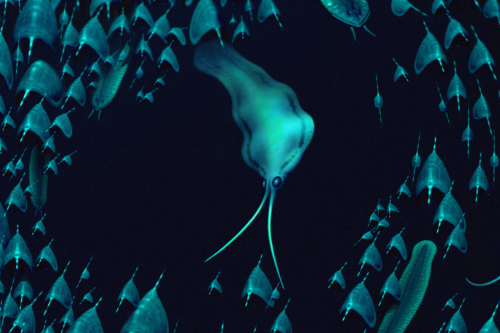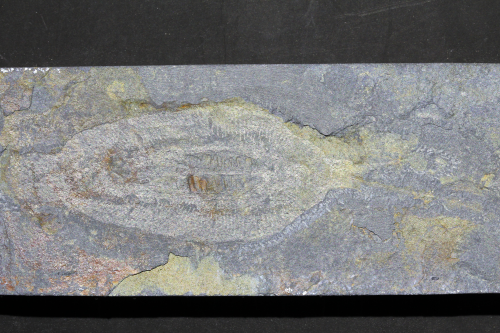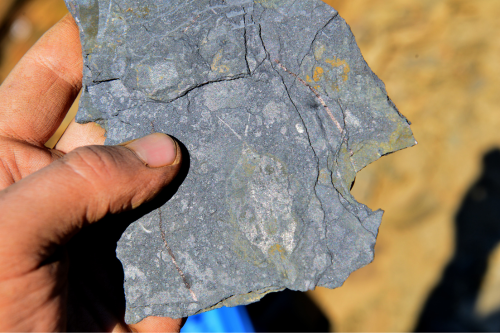
Reconstruction of Nektognathus, swimming in the Cambrian SeaBob Nicholls

The holotype specimen of Nektognathus from Sirius PassetTae Yoon Park

Specimen of Nektognathus as it was found in the field at Sirius Passet, North GreenlandTae Yoon Park
Remarkable fossils found in North Greenland have helped researchers solve a 500-million-year-old puzzle surrounding squid-like ancestors.
It was previously thought ancient organisms called nectocaridids, which bear a resemblance to squid, were a type of cephalopod – marine molluscs with tentacles and a prominent head. But scientists, co-led by the University of Bristol, have now shown these creatures are actually an early descendent of arrow worms, also known as chaetognaths.
This surprising discovery means the rather simple marine arrow worms had ancestors with much more complex anatomies and a predatory role higher up in the food chain.
The study, in partnership with palaeontologists at the Korean Polar Research Institute and University of Copenhagen, is the culmination of a series of excavation expeditions to Sirius Passet in North Greenland, which began nine years ago. The locality is famous for its extreme exceptional preservation of marine organisms from the Early Cambrian around 518 million years ago.
Co-lead author Dr Jakob Vinther, Associate Professor in Macroevolution at the University of Bristol, said: "Sirius Passet is a treasure trove of fossils from the Cambrian Explosion. We not only find delicate soft-bodied fossils but also their digestive systems, musculature and sometimes even their nervous system.
"Around 15 years ago a research paper, based on fossils from the famous Burgess Shale, claimed nectocaridids were cephalopods. It never really made sense to me, as the hypothesis would upend everything we otherwise know about cephalopods and their anatomy didn't closely match cephalopods when you looked carefully."
The research team's excitement grew as fossils of the mysterious nectocaridids were unearthed in Sirius Passet for the first time.
By analysing 25 fossil specimens, the researchers were able to pinpoint where nectocaridids fit into the tree of life. The solution came from Sirius Passets' unique preservation conditions resulting in their nervous systems commonly remaining intact.
"We discovered our nectocaridids preserve parts of their nervous system as paired mineralised structures, and that was a giveaway as to where these animals sit in the tree of life," Dr Vinther explained.
Recently, the team uncovered fossils in Sirius Passet belonging to another branch of the animal tree – a small group of swimming worms called arrow worms or chaetognaths.
"These fossils all preserve a unique feature, distinct for arrow worms, called the ventral ganglion," said co-lead author Dr Tae-Yoon Park of the Korean Polar Institute.
The ventral ganglion is a large mass of nerves situated on the belly of living arrow worms, which is unique to this type of creature. The unique anatomy of the organ combined with the special preservation conditions means it sometimes is replaced by phosphate minerals during decay.
Dr Park added: "We now had a smoking gun to resolve the nectocaridid controversy. Nectocaridids share a number of features with some of the other fossils that also belong to the arrow worm stem lineage. Many of these features are superficially squid-like and reflect simple adaptations to an active swimming mode of life in invertebrates, just like whales and ancient marine reptiles end up looking like fish when they evolve such a mode of life."
The discovery helps reveal clues about arrow worms and their past.
"Nectocaridids have complex camera eyes just like ours. Living arrow worms can hardly form an image beyond working out roughly where the sun shines. So, the ancestors of arrow worms were really complex predators, just like the squids that only evolved about 400 million years later," Dr Vinther added.
"We can therefore show how arrow worms used to occupy a role much higher in the food chain. Our fossils can be much bigger than a typical living arrow worm and combined with their swimming apparatus, eyes and long antennae, they must have been formidable and stealthy predators."
As further evidence for nectocaridids being swimming carnivores, the researchers found several specimens with the carapaces of a swimming arthropod, called Isoxys, inside their digestive tract.
The fossil is named Nektognathus evasmithae. The species name honours Professor Eva Smith, the first female professor of law in Denmark and renowned human rights advocate.
Dr Vinther said: "My decision to name our fossil after Eva, is that this animal was a smart and stealthy fighter just like she is."
Paper
'A fossilised ventral ganglion reveals a chaetognath affinity for Cambrian nectocaridids' by Jakob Vinther et al in Science Advances






